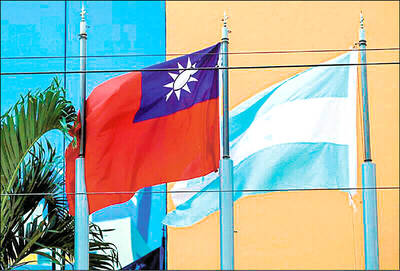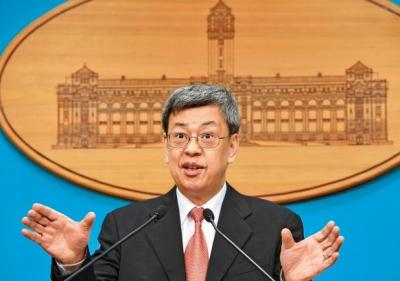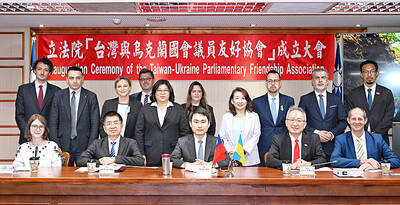Butterfly orchid producers have introduced radio frequency identification (RFID) technology in a move that is expected to raise productivity, agricultural researchers said on Thursday.
As competition in the global orchid market becomes increasingly fierce, research fellows at the Taiwan Agriculture Research Institute said the nation needs to introduce new technology to sharpen its competitive edge in the sector.
Saying that RFID is a powerful emerging technology that enables companies to keep better track of their assets, tools and inventories, the researchers said introduction of the technology to the orchid business will help improve the accuracy of order delivery dates and quantities, thereby increasing customer satisfaction.
If RFID technology is integrated with other automated production and management systems, local orchid productivity could also be raised significantly, the researchers said.
Saying that orchid cultivation — and butterfly orchids in particular — plays a very important role in the nation’s agricultural sector, an official from the Council of Agriculture’s (COA) Taiwan Agriculture Research Institute said Taiwan must pull out all the stops to breed new orchid hybrids and develop new cultivation know-how to maintain its market niche.
The latest statistics released by the council show Taiwan’s flower acreage totals about 13,475 hectares, with an annual production value of about NT$12.36 billion (US$374 million).
The figures account for only about 1.78 percent of Taiwan’s total agricultural production acreage and 7.34 percent of the total annual farming production value, respectively.
Despite the relatively small share of horticulture in terms of acreage and total production value, the official said the unit production value in the sector is about NT$918,000 per hectare.
Among the various floral species cultivated commercially, orchid farms cover about 592 hectares, but their combined annual production value amounts to NT$2.874 billion, representing a unit production value of NT$4.86 million per hectare and indicating that orchids are a high-yielding cash crop.
In comparison, butterfly orchids occupy an even more central role in terms of economic advantage. Butterfly orchids account for only 33.8 percent of the total orchids farmed but export value accounts for 75.2 percent of the total orchid production value.
These figures signify the importance of breeding new butterfly orchid cultivars and developing new cultivation technologies, the official said.
Through years of strenuous efforts, Taiwan has managed to develop greenhouses that suit the nation’s climatic conditions and has established a cultivation system that can ensure perennial blooming of orchids, the official said.
While local butterfly orchid production acreages and values have continued to increase, with Japan and the US serving as the principal export markets, the official said locally produced orchids have been facing ever fiercer competition from the Netherlands, China and Southeast Asia in recent years.
Against this backdrop, the official said, continued quality improvement and upgrading of productivity has become very important in the effort to sustain Taiwan’s butterfly orchid industry.

Several Chinese Nationalist Party (KMT) officials including Chairman Eric Chu (朱立倫) are to be summoned for questioning and then transferred to prosecutors for holding an illegal assembly in Taipei last night, the Taipei Police said today. Chu and two others hosted an illegal assembly and are to be requested to explain their actions, the Taipei City Police Department's Zhongzheng (中正) First Precinct said, referring to a protest held after Huang Lu Chin-ju (黃呂錦茹), KMT Taipei's chapter director, and several other KMT staffers were questioned for alleged signature forgery in recall petitions against Democratic Progressive Party (DPP) legislators. Taipei prosecutors had filed

Taiwan would welcome the return of Honduras as a diplomatic ally if its next president decides to make such a move, Minister of Foreign Affairs Lin Chia-lung (林佳龍) said yesterday. “Of course, we would welcome Honduras if they want to restore diplomatic ties with Taiwan after their elections,” Lin said at a meeting of the legislature’s Foreign Affairs and National Defense Committee, when asked to comment on statements made by two of the three Honduran presidential candidates during the presidential campaign in the Central American country. Taiwan is paying close attention to the region as a whole in the wake of a

President William Lai (賴清德) has appointed former vice president Chen Chien-jen (陳建仁) to attend the late Pope Francis’ funeral at the Vatican City on Saturday on his behalf, the Ministry of Foreign Affairs said today. The Holy See announced Francis’ funeral would take place on Saturday at 10am in St Peter’s Square. The ministry expressed condolences over Francis’ passing and said that Chen would represent Taiwan at the funeral and offer condolences in person. Taiwan and the Vatican have a long-standing and close diplomatic relationship, the ministry said. Both sides agreed to have Chen represent Taiwan at the funeral, given his Catholic identity and

Lawmakers from the Democratic Progressive Party (DPP) yesterday established a friendship group with their counterparts in Ukraine to promote parliamentary exchanges between the two countries. A ceremony in Taipei for the Taiwan-Ukraine Parliamentary Friendship Association, initiated by DPP Legislator Chen Kuan-ting (陳冠廷), was attended by lawmakers and officials, including Deputy Minister of Foreign Affairs Francois Wu (吳志中) and European Economic and Trade Office in Taiwan Director Lutz Gullner. The increasingly dire situation in Ukraine is a global concern, and Taiwan cannot turn its back when the latter is in need of help, as the two countries share many common values and interests,